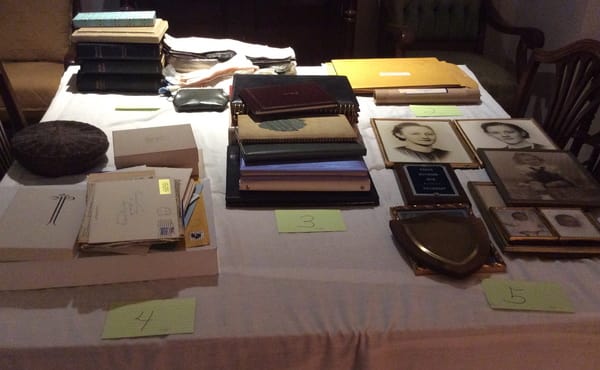Archiving My Mothers Things. Part IV. Layers and Containing
Archiving My Mothers Things. Part IV. Layers and Containing

Welcome to Part IV of our series “Archiving My Mother’s Things”. This is Nancy with Dusty Old Thing and this is the story of my journey to properly catalog and preserve the small things left by my mother, mainly the papers, the photos, the scrapbooks, the memorabilia, the family records. I’m also including the small things of her personal belongings: her grandmother’s buttons, handmade linens, dishes, jewelry, quilts, even her dozens of pairs of gloves. The large things, the furniture and lamps, are already in our household inventory.
Dealing with the things we’ve inherited is emotional. It’s also our chance to write part of our own story. As we archive, we develop the narrative, the legends we will pass on. We are in charge of the story. As my mother always said “Your life is what you make it.”
If you missed the earlier articles, you can still catch up. Part Iis the “why” we archive and why it is hard.
Part II is about establishing realistic objectives. When it gets hard this is our motivator. Part III is about getting a grasp on the size of the task and identifying where everything is. This fourth part is about getting inside those boxes or trunks in an orderly fashion and starting to think about how “the things” should be stored and documented from now on.
I like the book How to Archive Family Keepsakes by Denise Levenick (Family Tree Books). Her suggestions form the foundation for the technique I’m using. She recommends that, as we unpack boxes or trunks or any container, that we do so in layers. Those layers have a meaning. She recommends that we lay a white covering (I used a sheet), over a table. Then gently lift things out layer by layer, putting each layer in separate, numbered pile. In unpacking my mother’s small antique trunk, I had 5 layers. All are identified with a post-it. When I repack, it’ll be in the reverse order. This should not be a time consuming task. We are not stopping to read things or go through scrapbooks.
There should also be a trash basket nearby. Sometimes it’s clear that something needs to be tossed. This is not, however, the time for deep thinking about what to keep and what to toss. It’s just about the obvious…the fossilized mouse, old newspapers that were meant just for packing material, the candy box in which someone left a truffle.
This layering step allows us to see what’s in each container. It’s possible that in this step we find something valuable or treasured that needs to be removed right away to safer storage. Going through the layers also helps us better estimate the size of our task, to determine if we’re going to need help from other family members or from outside resources, and estimate what kinds of archival storage materials we may need to order.
Enter a short summary of the contents of each layer in the Grid or Inventory Summary sheet we talked about in Part III.
Things will go back in the trunk, but most will not stay there for long. They will go into archival quality boxes, tubes, folders, sleeves. We’ll get into those storage materials and sources for them in our next article. For now, however, we’d like to quote Levenick’s list for what to avoid when it comes to storage:
- “Plastic bins of any kind
- Plastic garbage bags
- Plastic containers made of polyethylene or polyvinyl chloride
- PVC storage of any kind
- Closets with exposed or adjacent plumbing
- Closets and cabinets in a kitchen or bathroom
- Unheated, uninsulated attics, garages, sheds
- Basement (beware of flooding)
- Old metal cookie tins.” (Levenick, p. 29)
She discourages the use of plastic bins for heirloom storage because they can trap moisture, leading to mold and mildew, and because they do not filter out damaging light. She is, however, practical and says, “What should you do if the storage medium isn’t perfect? Use the best available at the time, and change…when and if a better solution is discovered.” (p. 31). We’d like to add: “when it can be afforded”, too!
So, friends, let’s get on with the uncovering of the layers! We are discovering history.
SKM: below-content placeholderWhizzco for DOT

